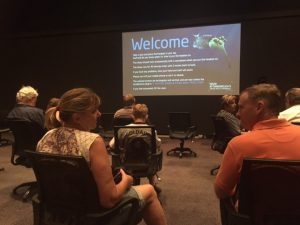David Attenborough's Virtual Reality Review

I don’t know about you, but I had a pretty exciting Canberra day public holiday. I sat on Sir David Attenborough’s knee whilst floating through the depths of the Great Barrier Reef…Apologies for the ‘mum’ joke, but in my defence heading off to the National Museum of Australia (NMA) for David Attenborough’s virtual reality experience has been the first child-free outing I have had in several months #mumlyf.
My ‘wild’ day out set me back $20 (would have been more for parking at the NMA, but I went on a public holiday) and was a super stylish affair, thanks to virtual reality (VR) headsets and earphones required to view (and hear) the two short documentaries that ran for a total of 30 minutes.
I must admit that when I first entered the viewing room at the NMA, I had fears that the experience was going to be very disappointing. The room was set-up with 50 (swivel) office chairs and was screaming ‘amateur hour’, I wondered why the NMA hadn’t selected their on-site theatre to host this experience. However once the first documentary began,
However once the first documentary began, Great Barrier Reef Dive, and a submarine-type vessel transported us under the sea, i.e. David Attenborough and I (oh, some of his crew members and a professor from the University of Queensland, Justin Marshall were there too), it soon became apparent that being able to swing around in a 360-degree fashion was a necessity for this experience. The three-dimensional, 360-degree camera angles were without a doubt the highlight of this entire experience. Everywhere you looked there were different things to see, from scuba diving film crews to the tiniest of sea creatures.
The three-dimensional, 360-degree camera angles were without a doubt the highlight of this entire experience. Everywhere you looked there were different things to see, from scuba diving film crews to the tiniest of sea creatures.
The Barrier Reef Dive documentary ran for 20 minutes and introduced the audience to a number of sea creatures whilst discussing the ecological aspects of the reef. The 360-degree underwater views were incredible and made me feel as though I was in that submarine with Sir David and his crew, although I wish I had of been sitting a comfortable distance away from the man himself, as it really did feel as though I was on his knee.
The crew chatters and beautiful views outside the submarine made it a little difficult for me to actually focus on Sir David’s commentary; therefore I am no more the wiser about the Great Barrier Reef.
The second documentary, First Look, used computer generated imagery (CGI) and narration by Sir David to tell the story of the beginning of life on Earth, introducing the audience to the earliest sea life in ancient oceans of 500 million + years ago. This documentary ran for ten minutes and the CGI graphics were amazing and at times flew towards the audience at full speed.
I’m just not sure why this documentary didn’t feature before Great Barrier Reef Dive, as it offered great detail about the evolution of marine life and would have served as an introduction into the Great Barrier Reef, as it exists now. I wondered also why the two documentaries hadn’t been combined to make one 30-minute documentary and my only conclusion to this was that one was in CGI, whilst the other was filmed footage.
I can fully appreciate the advancement of technology that allowed this experience to be possible, however, I found the VR headgear to be very heavy on my face and really uncomfortable, which distracted me throughout the two documentaries. Also, I had questioned whether my eyesight was on the ‘blink’…apologies for another terrible joke, so I was pleased to hear mumbles from a few people behind me that the vision was blurry, despite the focus wheel functionality within the headset. Despite all of this, I can appreciate this technology is reasonably new.
The experience as a whole was fun and offers something different for locals and visitors to Canberra to do, however, it all felt very ‘gimmicky’, and wouldn’t appeal to those wishing to learn a great deal about the Great Barrier Reef or the evolution of marine life. Far be it for a third-year university student to critique a Sir David Attenborough production, however, for me, it was obvious the documentaries had been produced for entertainment rather than educational purposes and to showcase this brand new VR technology.
For this reason, I think the actual angle of the Great Barrier Reef Dive would have been far more interesting if based upon the making/behind the scenes of a documentary about the Great Barrier Reef, with little (or no) commentary, as the conversations between Sir David and his crew were far more entertaining in this instance.
Was it worth $20? Yes. Could my childfree afternoon have been better spent elsewhere? I am yet to decide, but I do feel excited about the future relationship between VR technology and films!



Be the first to comment!